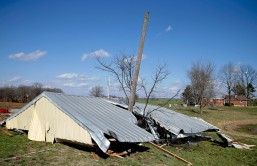One of the world's strangest scientific mysteries was discovered when a geologist stumbled across a massive mound 65 years ago, UK MailOnline reported.
Discovered in 1949, the site in Irkutsk, Siberia is a huge convex cone with a funnel-shaped recess and a rounded hill in the middle, which looks a little like an eagle's nest with an egg nestled inside it.
For decades, scientists have been baffled by the origin of the Patomskiy crater, which is named after a nearby river. The theories for its existence have ranged from a nuclear blast to a secret gulag mine and even a meteorite strike.
According to UK MailOnline, the current thinking is that the site was indeed created by a meteorite strike, but no evidence has been found to support the theory.
The cone is 80 meters tall and has a diameter of 150 meters at its widest. The depth of the inner circle ditch is around 10 meters.
Vadim Kolpakov, who discovered the crater, tried and failed to arrange a scientific trip to examine the site, but numerous expeditions have taken place since and samples were collected in 2013.
As there were not enough people living nearby when the crater is thought to have formed to create such a pile, theories that the mound is a giant slagheap have been thrown out.
And there were never labor camps or gulags in the region, UK MailOnline reported.
"Half a ton of samples were taken from the site and removed by helicopter last year," UK MailOnline reported. "The samples led scientists to dismiss ideas of a uranium ore explosion as the background radiation at the site is low and no uranium has been found nearby either."
This left them with two main theories - one of a volcano and another of a meteorite.
However, the mysterious site has not given up any meteoritic material and the area is not thought to be volcanic, UK MailOnline reported.
Within thousands of kilometers of the Patomskiy crater, there are no volcanoes and it also seems to be relatively new.
"Scientists thought the crater was only between 100 and 500 years old and could be the result of the Tunguska meteorite, which fell in the Krasnoyarsk region in 1908, but whose crater has never been discovered," UK MailOnline reported. "It is thought the meteorite was sighted just 70km away from the 'eagle's nest' and that distance is a mere 10 to 15 seconds of flight."
As the Tunguska event occurred in 1908, the age coincides, but modern tests have shown that the crater is actually 250 years old - so it could have been formed by a previous meteorite that fell when the area was virtually unpopulated.
Between 100 and 150 meters underneath the crater, scientists think that there is something buried with a high iron content and ferromagnetic materials.
Although they are not certain, they believe it could be a meteorite or another incredibly dense object.
The fact that the crater is 'alive' as its shape changes constantly - by rising and falling - and that the trees nearby the site are reported to grow abnormally fast, adds to the mystery, UK MailOnline reported.








